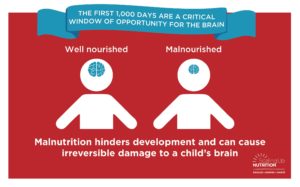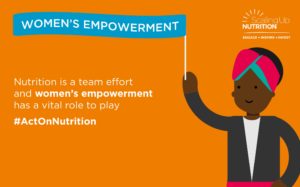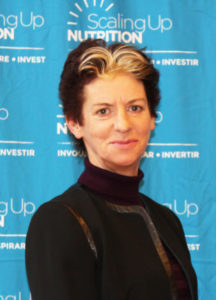Nutrition & Education: More Than Food For Thought
[vc_row row_type=”row” text_align=”left” css_animation=””][vc_column][vc_column_text custom_options=””] A blog by @GerdaVerburg, SUN Movement Coordinator originally published in the Women Deliver‘s website http://womendeliver.org/2018/nutrition-education-food-thought [/vc_column_text][/vc_column][/vc_row][vc_row row_type=”row” text_align=”left” css_animation=””][vc_column][vc_separator type=”normal” color=”#dd9933″][/vc_column][/vc_row][vc_row row_type=”row” text_align=”left” css_animation=””][vc_column][vc_column_text custom_options=””] In February, the world will gather in Dakar, Senegal, for the Financing Conference of the Global Partnership for…
[vc_row row_type=”row” text_align=”left” css_animation=””][vc_column][vc_column_text custom_options=””]
A blog by @GerdaVerburg, SUN Movement Coordinator originally published in the Women Deliver‘s website
http://womendeliver.org/2018/nutrition-education-food-thought
[/vc_column_text][/vc_column][/vc_row][vc_row row_type=”row” text_align=”left” css_animation=””][vc_column][vc_separator type=”normal” color=”#dd9933″][/vc_column][/vc_row][vc_row row_type=”row” text_align=”left” css_animation=””][vc_column][vc_column_text custom_options=””]
In February, the world will gather in Dakar, Senegal, for the Financing Conference of the Global Partnership for Education – a key partner of the Scaling Up Nutrition (SUN) Movement – to ensure 870 million girls and boys will get the schooling they need for the future we want. This is one of the most worthwhile investments for any country today.
Much progress has been made in bridging the gender gap in primary education. But, still,131 million girls were not in school in 2015, meaning very little progress towards any of our universal Sustainable Development Goals (SDGs) can be made. So, there is much work ahead, as we have promised to leave no one behind.
Whereas education is one of the most important investments, it would be naïve to think that the rest will (necessarily) follow, unless a good nutrition policy is taken care of – with women and girls at the centre – from the get-go. Education is an essential element to reduce malnutrition – in all its forms. This key message should be kept in mind by every politician and decision-maker: If women in low and lower middle-income countries have finished their secondary school, the number of children too short for their age – or stunted – is reduced by 26 per cent. In other words, a great stride towards securing the prospects of a country and its people. Another message is that the 155 million stunted children today are likely to be unprepared to learn tomorrow, if they go to school at all, by having lower attendance, shorter attention spans, lower performance scores and more health-related problems than well-nourished kids.
 The Lancet argues that malnourished girls and boys who have not been given the stimulation and care they need will earn more than 25 per cent less than those children who received the best possible start in life – especially during the first 1,000 days – with adequate nutrients. Emphasizing this extra, well-educated girls and women are healthier, happier, earn more, have fewer children and are thus better able to take care of themselves and others. On top of this, the benefits of educating girls are transferred from generation to generation and across families and communities.
The Lancet argues that malnourished girls and boys who have not been given the stimulation and care they need will earn more than 25 per cent less than those children who received the best possible start in life – especially during the first 1,000 days – with adequate nutrients. Emphasizing this extra, well-educated girls and women are healthier, happier, earn more, have fewer children and are thus better able to take care of themselves and others. On top of this, the benefits of educating girls are transferred from generation to generation and across families and communities.
What I know now, that I did not know before becoming the SUN Movement Coordinator is that stunting not only affects the body but also the brain development. And that it predicts poorer cognitive and educational outcomes in later childhood and adolescence. This has been reaffirmed by the 2016 Global Nutrition Report and the SUN Movement Annual Progress Report, launched in November 2017. Both show the causal link between female secondary school enrolment and stunting reduction. I am sad to say that today, only 9 (out of 60) SUN Countries are above this threshold, in terms of ensuring girls and women enrol in and attend secondary school. And this means that it’s high time to roll up our sleeves to reverse this trend.
This needs to start with encouraging parents and communities to send their girls (and boys) to school and ensure they stay in school, at the secondary level and beyond. Decision-makers must make sure that schools are safe, equitable and inclusive – to reap the most benefits for individuals, families and economies. Schools also have great potential to reach children most in need with both nutrition education and nutritious meals at lunchtime, in addition to good sanitation, health and hygiene becoming a part of the curricula in many countries – which is a great step. Simply put, the big challenge facing schools is to respond to the need for cost-effective approaches that support the essential nutrition-learning nexus.
 And if we think this is only a low-income concern, I assure you, schools and education facilities can also have a key role in addressing the ‘ticking time bomb’ that overweight and obesity present, which disproportionally affect women and girls. Overweight and obesity threaten to hamper progress in most countries of the world. Nutrition education is not just learning about foods and nutrients, but learning what to do and how to improve nutritious behaviour. If healthcare professionals do not impart the knowledge that breastmilk, for instance, makes for more intelligent children, how can we expect parents to know that?
And if we think this is only a low-income concern, I assure you, schools and education facilities can also have a key role in addressing the ‘ticking time bomb’ that overweight and obesity present, which disproportionally affect women and girls. Overweight and obesity threaten to hamper progress in most countries of the world. Nutrition education is not just learning about foods and nutrients, but learning what to do and how to improve nutritious behaviour. If healthcare professionals do not impart the knowledge that breastmilk, for instance, makes for more intelligent children, how can we expect parents to know that?
Although there is nothing ‘new’ about the importance of linking malnutrition and education, and vice versa, it does offer us a new way of thinking (and working) – towards the achievement of the SDGs – as one goal cannot be met without the other. This is how we see our work in the SUN Movement: better nutrition is the enabler for better education, development, and, thus, a better for your country and people, alike, making sure that no one is left behind.
As the World Economic Forum predicts, the economic gender gap is unlikely to be closed for another 217 years. But things are looking up for the education-specific gender gap, which might inspire us in 2018 and beyond. If we get the gender parity in education right within the next 13 years (which incidentally coincides with the deadline for meeting the SDGs), we are a big step closer.
[/vc_column_text][/vc_column][/vc_row][vc_row row_type=”row” text_align=”left” css_animation=””][vc_column][vc_column_text custom_options=””]
 So, let us #FundEducation and #InvestInNutrition. It’s time to speak up and speak out about why investing in education – and more specific in girls’ education – is crucial to end malnutrition, once and for all. But, also, conversely, why investing in girls’ nutrition, will render undereducation a thing of the past. And that is more than just food for thought, it’s an actual win-win
So, let us #FundEducation and #InvestInNutrition. It’s time to speak up and speak out about why investing in education – and more specific in girls’ education – is crucial to end malnutrition, once and for all. But, also, conversely, why investing in girls’ nutrition, will render undereducation a thing of the past. And that is more than just food for thought, it’s an actual win-win
[/vc_column_text][/vc_column][/vc_row][vc_row row_type=”row” text_align=”left” css_animation=””][vc_column][vc_separator type=”normal” color=”#dd9933″][/vc_column][/vc_row]
